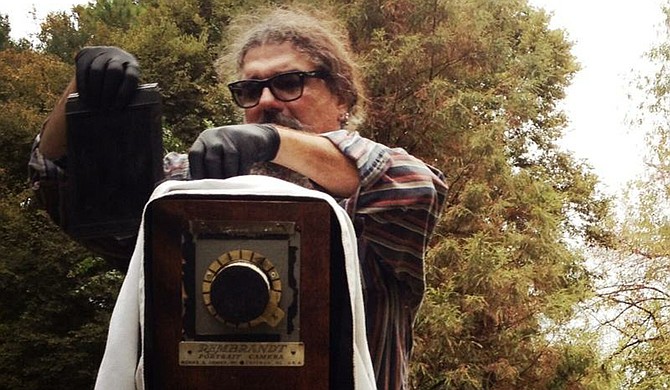Photographer and artist Euphus Ruth began primarily as a filmmaker before moving into the world of photography.
The Texas native, who was raised in Bruce, Miss., uses a process known as collodion, which is an early photographic process developed around 1850. The technique, which Frederick Scott Archer invented in 1851, involves adding a soluble iodide to collodion, or cellulose nitrate, and coating a glass plate with the mixture. In the darkroom, the photographer immerses the plate in a solution of silver nitrate, which forms silver iodide. While the plate is still wet, the camera exposes it. Then, the photographer pours a ferrous sulfate solution and fixes the photograph with potassium cyanide. A coat of gum sandarac varnish preserves the plate.
By the end of the century, the process was pretty much replaced by newer methods. However, collodion processing gives photos a fine detail and captures images in great depth. Photographers have refined this process and use it today.
This style gives Ruth's photographs an almost other-worldly feeling. In addition to using older techniques like collodion, Ruth also prefers vintage equipment when taking photos.
"My love for black and white photography began by looking at photos from my Mom's Kodak Brownie, which was kept in a box under the couch of our family home," the artist says in his website biography. "I am inspired by things olden, forgotten or remembered and intrigued by the earth's reclamation, be it human or material. Most of my images since 2006 are made with wooden view cameras with antique and modern lenses practicing the 19th-century wet collodion process. Currently, I am practicing making wet collodion glass negatives for contact printing."
Ruth is involved in the entire process of photography. Using older methods requires more than simply pointing the camera at something and shooting it. He not only visualizes the image through the ground glass, but he sees the process through to the final stage in the darkroom.
He became interested in the process after attending photographer John Coffer's wetplate collodion workshop in 2005. "This decision came after a few years of trying to emulate the 19th century photographic look in the darkroom," Ruth says. "Working and creating in this process has enabled me to portray moods and emotions I could never do with film."
Euphus Ruth's work is part of the Museum After Hours Pop Up at the Mississippi Museum of Art (380 S. Lamar St.). The pop up, titled "Analog v. Digital," examines the work of artists such as Charles and Talamieka Brice, who work in the digital realm, and Ruth, who works in the analog realm. The pop-up is in conjunction with Art Bar Pop Trivia, High Note Jam, Screen on the Green, and Dinner and a Movie: A Food Truck Festival. "Analog v. Digital" is free to the public and will have a cash bar and food for purchase. For more information, visit msmuseumart.org and euphusruth.com.



Comments
Use the comment form below to begin a discussion about this content.